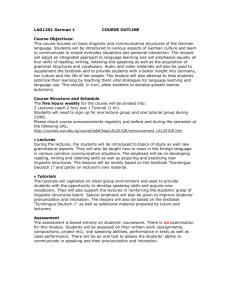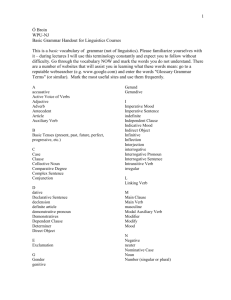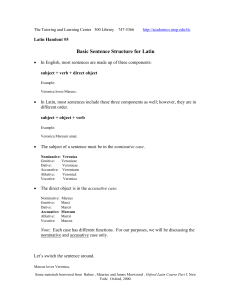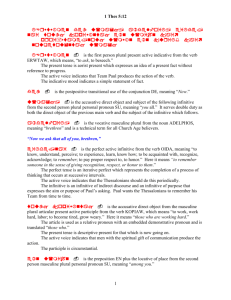French Object Agreement with Verbs of Perception
advertisement
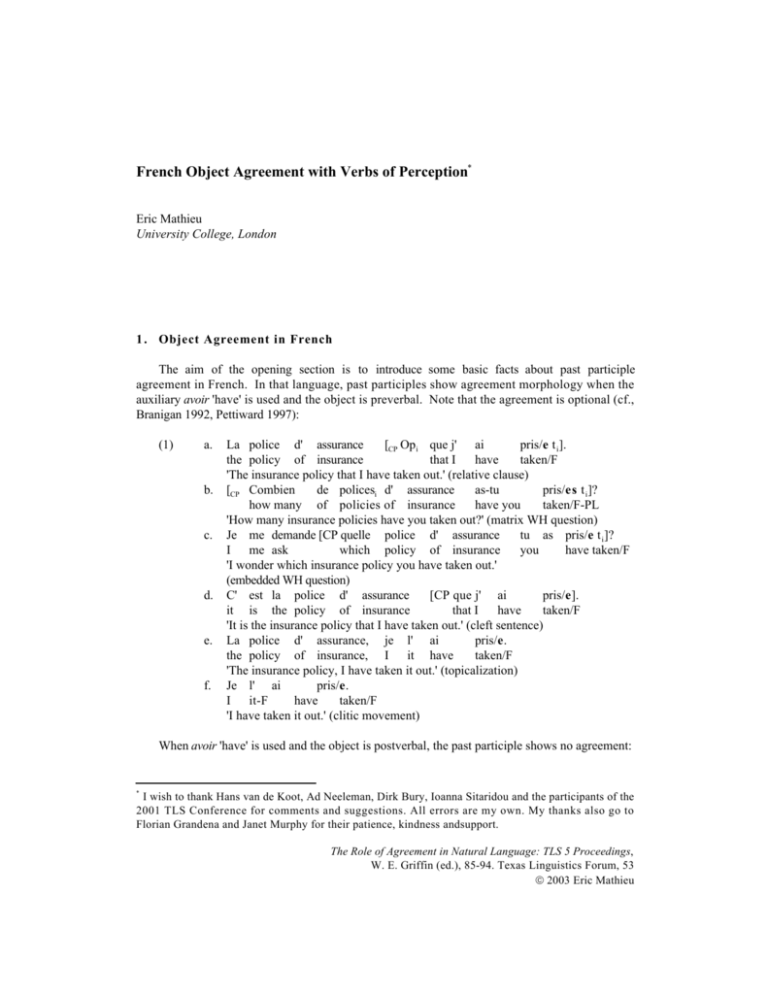
French Object Agreement with Verbs of Perception* Eric Mathieu University College, London 1 . Object Agreement in French The aim of the opening section is to introduce some basic facts about past participle agreement in French. In that language, past participles show agreement morphology when the auxiliary avoir 'have' is used and the object is preverbal. Note that the agreement is optional (cf., Branigan 1992, Pettiward 1997): (1) a. b. c. d. e. f. La police d' assurance [CP Opi que j' ai pris/e t i ]. the policy of insurance that I have taken/F 'The insurance policy that I have taken out.' (relative clause) [CP Combien de policesi d' assurance as-tu pris/es t i ]? how many of policies of insurance have you taken/F-PL 'How many insurance policies have you taken out?' (matrix WH question) Je me demande [CP quelle police d' assurance tu as pris/e t i ]? I me ask which policy of insurance you have taken/F 'I wonder which insurance policy you have taken out.' (embedded WH question) C' est la police d' assurance [CP que j' ai pris/e]. it is the policy of insurance that I have taken/F 'It is the insurance policy that I have taken out.' (cleft sentence) La police d' assurance, je l' ai pris/e. the policy of insurance, I it have taken/F 'The insurance policy, I have taken it out.' (topicalization) Je l' ai pris/e. I it-F have taken/F 'I have taken it out.' (clitic movement) When avoir 'have' is used and the object is postverbal, the past participle shows no agreement: * I wish to thank Hans van de Koot, Ad Neeleman, Dirk Bury, Ioanna Sitaridou and the participants of the 2001 TLS Conference for comments and suggestions. All errors are my own. My thanks also go to Florian Grandena and Janet Murphy for their patience, kindness andsupport. The Role of Agreement in Natural Language: TLS 5 Proceedings, W. E. Griffin (ed.), 85-94. Texas Linguistics Forum, 53 2003 Eric Mathieu 86 ERIC MATHIEU (2) J' ai pris/*e une police d' assurance. I have taken-F a policy of insurance 'I have taken out an insurance policy.' We now turn to the problem with which the present paper is concerned. 2 . The Problem In French, when followed by an infinitive, verbs of perception sometimes carry agreement, sometimes do not. 1 (3) a. b. La pianiste que j' ai the-F pianist that I have 'The pianist who I heard play.' La musique que j' ai the-F music that I have 'The piece of music that I heard played.' entendu*(e) jouer. heard-F to play entendu/*e heard jouer. to play As far I know, the contrast between (3a) and (3b) has not been discussed in the generative grammar literature before. The problem we face is twofold: i. how to account for (3a); ii. how to account for the difference between (3a) and (3b). I argue that the difference between (3a) and (3b) follows from case theory. The presence versus absence of agreement is not a case of optionality. Agreement is obligatory in (3a), and impossible in (3b). (3a) and (3b) do not have the same underlying configuration. In (3a) la pianiste is the logical subject of the infinitive jouer whereas in (3b) la musique is the logical object of the infinitive. (3a) is an Exceptional Case Marking (ECM) construction, Op checks accusative Case with entendu. PRO is the subject of the infinitive and it is coindexed with Op. I argue that, on the other hand, (3b) does not involve control, but a specified nominative subject (i.e., la musique) which has been 'promoted', the infinitive being a passive verb. The latter also checks accusative Case with the object. Evidence for this claim comes from the fact that la musique can be replaced by an accusative pronoun. Accusative Case checking is not with the higher verb, since there is no agreement on that verb. The theory of DP raising I assume relies on mechanisms and assumptions that are different from Burzio's generalization. I make use of Williams' (1980) theory of argument structure as adapted by Neeleman & Weerman (1999). The paper is organized as follows. Section 3 argues for a direct relation between Case and agreement and provides some background theory about null Case and case checking in ECM constructions. Section 4 provides a tentative analysis of the problem discussed in the present section. We conclude in section 5. 1 The agreement is not heard. Past participle agreement is audible in French if past participles end with a consonant. Unfortunately, I have found no verbs of perception which take a final consonant in the past participle. Although the rule in (3) may appear prescriptive, it is nevertheless real and must have its roots in more creative processes. Having said that, I admit that, today, the rule does not belong to core grammar and is thus peripheral. OBJECT AGREEMENT IN FRENCH 87 3 . Background 3.1 Case checking In Government and Binding theories of Case, there was an asymmetry between the assignment of nominative and accusative Case. While nominative Case was assigned via a Specifier-Head relation, accusative Case assignment was not. The latter was assigned under government. In the Minimalist Program (MP, cf., Chomsky 1995), the concept of government is abandoned, and it is argued that both nominative and accusative Case assignment are achieved via Specifier-Head agreement. Accusative case is checked in a Spec-Head configuration within an agreement projection called AgroP, the equivalent of Kayne's (1989) object agreement phrase. In the MP, Case and agreement are thus unified (I shall discuss the multiple Spec theory which is a variant of the agreement projection theory, cf., Chomsky 1995: Ch.4). However, while nominative and accusative features are checked in the specifier positions of AgrsP and AgroP, respectively, the features relevant for checking Case do not reside in Agrs and Agro, but in T and V, respectively. In other words, the category in Spec of Agr is determined by the featural Case assigning properties of V (for the object), and T (for the subject), and not by Agr itself. The MP has a strong lexicalist flavor in that DPs and heads come fully inflected in the lexicon. There is no Case assignment as such, but matching/checking of features. The technicalities of derivations involving Case are as follows: T raises and adjoins to Agrs, and V raises and adjoins to Agro. These head-movement create complex heads which contain the f-features of Agr as well the Case features of V/T adjoined to Agr. It has been argued in the literature (cf., Friedemann and Siloni 1997) that there cannot be a direct link between French past participle agreement and accusative Case checking, since, in that language, agreement appears possible without the presence of case checking. French past participle agreement is obligatory in passive sentences and with unaccusative verbs (cf., Branigan 1992, Pettiward 1997): (4) a. b. Elle est allée/*allé en vacances. She is gone-F on holiday 'She went on holiday.' (unaccusative) Elle a été réveillée/*réveillé. she has been woken-F 'She was woken up.' (passive) On the assumption that both unaccusative and passive verbs do not check accusative Case, Fridemann and Siloni conclude that the agreement in (4) occurs independently from Case checking. Friedemann and Siloni also note that there are cases where participle agreement is triggered with non accusative elements (in 5, elle, the subject), although an accusative argument appears in the sentence: (5) Elle s' est réveillée/*réveillé she herself is woken-F 'She woke up at five.' (reflexive) à at cinq five heures. hours 88 ERIC MATHIEU Contra Friedemann and Siloni (1997), we argue that there is a link between agreement and accusative Case. Evidence for this claim comes from the contrast between (6a) and (6b). In (6) the past participle agrees with a direct object (6a), but not with an indirect object (6b - a reciprocal construction): (6) a. b. Les enfants se sont regardés/*regardé dans the children themselves are looked-PL in 'The children looked at themselves in the mirror.' Elles se sont parlé/*parlées. they one another are spoken 'They spoke to one another.' la glace. the mirror In (6a), se is the direct object of regardé. In (6b), The verb parler takes an indirect object; therefore there is no agreement with se. Similarly, in (7a), the verb couper takes a direct object; therefore the participle agrees with se. In (7b), however, la main is the direct object (se here becomes an indirect object pronoun indicating whose hand was cut) and here no agreement is possible: (7) a. b. Elle s' est coupée/*coupé. she herself is cut-F 'She cut herself.' Elle s' est coupé/*coupée la main. she herself is cut the hand 'She cut her (own) hand.' Object agreement in French thus correlates with accusative case checking, it is sensitive to the distinction between direct and indirect objects. In order to explain why agreement surfaces in (4a) and (4b) despite the fact that we are dealing with a passive and an unaccusative verb, we follow a theory which is very different from the theories that stem from Burzio's generalization. Following ideas by Williams (1980), Neeleman and Weerman (1999) propose that NP raising can be explained straightforwardly if the process is analyzed as base generation of a subject plus null (A') operator movement to Spec-VP. Movement of the null operator provides VP with a qrole (an external q-role, that is) which it otherwise lacks: (8) a. b. Johni [VP Opi was fired ti ]. Johni [VP Opi fell t i ]. This proposal replaces the traditional assumption that the trigger for NP raising is casetheoretical in nature (Burzio's generalization). NP raising is due to predicate formation and thus no reference to Burzio's generalization needs to be made. Apart from the fact that it is a mere stipulation, there are several empirical problems for Burzio's generalization, one of which being the following: why would the passive of verbs selecting a PP complement not be formed by simple omission of the subject as in (9)? OBJECT AGREEMENT IN FRENCH (9) a. b. 89 Many people talk [about this actress]. * ____ was/be talked [about this actress] by many people. (Neeleman and Weerman 1999: 207) To quote Neeleman and Weerman: 'why, in other words, are there no ergative verbs that select a PP as their sole argument?' (1999: 207). The fact that (9b) is ill-formed shows that movement of the DP to Spec-IP is not driven by case considerations. The DP is already case-marked by the preposition, so no Case checking is required; still, the sentence is ungrammatical. It must be the case then that movement to Spec-IP is due to reasons other than case-checking. Now, suppose that the unaccusative verb and the passive verb are both associated with two qroles, one internal and one external. The NP in Spec-IP thus receives nominative Case while the verb assigns accusative Case to the trace of the operator: (10) a. b. John-NOM [Opi was promoted t-ACCi yesterday]. John-NOM [Opi arrived t-ACCi yesterday]. This way, we account for the agreement property of the verbs in (4a) and (4b). The conjecture is thus that we have agreement precisely because accusative Case has been checked. The conclusion is that there is a direct link between agreement and Case. Now the background about accusative Case checking is in place, let us turn to null Case. 3.2 Null Case The null Case theory goes against the traditional account of control and ECM/raising structures according to which the differences between the two kinds of constructions stem from cselection: (11) a. b. John believed [AgroP him j [IP t i to be crazy]]. *John believed [IP PRO to be crazy]. (12) a. b. John tried [CP PRO to win]. *John tried [AgroP him j t i [CP [IP t j to win]]]. On the traditional c-selection view, whereas the verb try c-selects a CP projection, the verb believe c-selects IP. Assuming accusative Case is checked in Spec-AgroP, the pronoun him, in (11a) and (12b), has to move to that position so that the accusative Case feature it bears is checked. This is not possible in (12b), because movement is blocked by an intervening CP projection. A-movement out of a CP projection is prohibited. It follows from the Improper Movement Constraint or, alternatively, from the ECP. In (12a), the CP protects PRO from being governed by the verb try. In (11b), however, PRO is governed by the verb believe and the construction is ruled out by either Condition A or Condition B of the Binding theory. There are conceptual and empirical problem with the cselection/binding theoretic account of the distinction between control and non-control structures. I won't iterate the arguments here (see Boskovic 1997 for discussion). 90 ERIC MATHIEU Chomsky and Lasnik (1993) theory of PRO does not appeal to the notion of c-selection or government. Instead, it is argued that PRO is always Case-marked. It moves from an underlying position (i.e. Spec-VP) to Spec-IP in order for its Case to be checked. Evidence that PRO moves comes from sentences with passive infinitives (13): (13) John hates PROi to be interrupted ti . Chomsky and Lasnik's (1993) proposal is: 1/ [- finite] checks null Case, 2/ PRO (and only PRO) has null case (and can bear no other Case features). However, their proposal is insufficient to account for the distribution of Case in ECM and raising constructions (cf. Watanabe 1993, Martin 1996) and inflected infinitival clauses (Wharram 1997). 3.3 Case-checking and ECM Constructions In order to account for ECM and raising constructions, we need to make a distinction between the feature case-checking properties of I. The idea takes as its point of departure Stowell's (1982) work on tense. According to Stowell (1982), control structures have an internally specified unrealized tense in the embedded clause. ECM and raising structures, on the other hand, involve no internally specified unrealized tense. In this case, the tense of the complement clause is directly determined by the matrix verb. With control structures it is not the case. Building on Stowell's observation, Martin (1996) proposes that the feature content of I in control structures differs from that of I in ECM/raising constructions. Control and ECM/raising constructions are both [-finite], but differ in that the I head of control structures has an internally specified unrealized [+tense] feature, while the I head of ECM/raising verbs has a [-tense] feature directly determined by the matrix predicate. The distinction is thus between [-finite]/[+tense] for control structures and [-finite]/[-tense] for ECM/raising constructions. Consider some examples (NC = null Case): (14) a. NC NC John wants [CP [IP PRO i checks null Case b. NOM NOM Johni I seems [IP t i to be working]. does not check Case c. ACC ACC John wantsi [AgroP himj ti [IP t j to work]]. does not check Case I to [t i work]]]. I à [-finite]/[+tense] I à [-finite]/[-tense] I à [-finite]/[-tense] In (14a), embedded I comes with a [-finite]/[+tense] feature matrix which means that I checks null Case. Note that it now makes no difference whether or not a CP is projected. In (14b), embedded I does not check Case, because it bears the features [-finite]/[-tense]. The verb seem cannot check the case features of John, so John moves to Spec-IP where it checks its nominative feature against the nominative feature of matrix I. In (14c), again, embedded I does not check Case, because in this instance, embedded I bears the features [-finite]/[-tense], so him checks its accusative feature against the accusative feature in Agro. OBJECT AGREEMENT IN FRENCH 91 In sum, the differences between control and ECM/raising structures has nothing to do with presence or absence of a CP projection. The distribution of each construction follows from Case theory. 4 . Basis for a Solution With the background in place, we are now ready to tackle the problem with which this paper is concerned, i.e., the fact that there is agreement in (3a), but not in (3b). 4.1 Accounting for (3a) We argue that (3a) is an Exceptional Case Marking (ECM) construction while (3b) is not. In (3a), Op is assigned a q-role (AGENT) by jouer, but since [-finite]/[-tense] I cannot check null case features, Op 'receives' case from entendu: (3a) La pianiste [CP Opi que j'ai [Spec-AgroP ti' the-F pianist that I have 'The pianist who I heard play.' entendue j [VP t j [IP ti heard-F jouer]]]]. to play The observation in (3a) is at odds with the claim that participle agreement is not possible with subjects of infinitives; only with subjects of small clauses (cf., Ruwet 1982, Kayne 1989, discussion in Boskovic 1997). According to Kayne (1989), the object passes through the specifier of an object agreement phrase before it lands in Spec-CP: (15) a. b. *La fille [CP1 Opi qu' il a [Spec t i ' AGR obj dite [CP2 être [ SC t i malade]]]]. the-F girl that he has said-F to be ill 'The girl who he said was ill.' La fille [CP Op i qu' il a [Spec ti ' AGR obj dite [SC t i malade]]]. the-F girl that he has said-F ill 'The girl who he said was ill.' Kayne (1989) claims that (15a) involves a CP projection while (15b) involves only a small clause, i.e., no IP or CP. Past participle agreement is not possible in (15a) because Op has to move to Spec-CP2 on its way to the specifier of the agreement phrase. Movement from an A' to an A-position is prohibited. This is made to follow from the Improper Movement Constraint. Alternatively, (15a) can be ruled out as a violation of the ECP: Op cannot move directly to the specifier of the object agreement phrase, because the CP-IP combination is crossed. In sum, A movement cannot cross a CP boundary. In (15b), there is only a small clause complement, so the problem of movement from A' to A-position does not arise, government and case assignment are possible across a small clause boundary. There is a consensus in the literature that small clauses do not contain a CP projection. Kayne does not discuss object agreement with verbs of perception. But his theory seems to predict that, since (3a) contains an infinitive, the past participle selects a CP rather than a small clause. On his view, participial agreement in (3a) is thus completely unexpected. 92 ERIC MATHIEU 4.2 Accounting for (3b) Let us now turn to the case of (3b). We argue that (3b) is not an ECM construction where Op and PRO are coindexed: (16) La musique [CP Opj que j' ai [Spec-AgroP t j entenduk [VP t k t j jouer]]]]]. the-F music that I have heard [Spec-IP PROi [Spec-VP t i to play 'The piece of music that I heard played.' Op is not the object of entendu, since there is no agreement with entendu. Recall that we have shown that there is a direct relation between object agreement and accusative Case checking. We argue that in (3b), Op is the object, not of the finite, but of the infinitival V. The object of the finite V is the whole VP. Op receives a q-role (THEME) from jouer. Op originates as a sister of the verb infinitival verb. The construction in (3b) is like a causative construction in that the DP cannot appear preverbally (cf., Guasti 1997). In (3b) movement of a null operator takes place. Movement of the operator to Spec-VP provides a q-role to the VP. In turn, the verb nominative can be assigned to the subject. We conjecture that the VS order stems from the fact that clause union has occurred and not from the fact that the subject has remained in postverbal position: (17) J' ai entendu jouer une musique. I have heard to play a music 'I heard a piece of music played.' With causatives and optionally with verbs of perception, the embedded verb moves higher to the matrix verb (at least in Romance). The VS order is characteristic of infinitival constructions with specified subjects such as inflected (European Portuguese) and personal (Spanish) constructions (cf., Menshing 2000, Sitaridou 2000). In those, clause union typically occurs too (Mathieu and Sitaridou 2001). (3b) involves no PRO coindexed with an empty subject position (say, pro). Instead, the contention we put forward is that in (3b) the DP la musique is a specified nominative subject based generated in Spec-IP. The marked nature of (3b) (see footnote 1) now follows from the fact that Modern French no longer has specified nominative subjects in infinitives. (3b) is thus a residue from older stages of the language when nominative subjects could appear in non-finite contexts. Old French had personal infinitives (cf., Roberts 1993): (18) a. b. Viendra jamais le jour qui doit finir ma peine? come-3FUT-SG ever the day that must to finish my pain? 'Will it ever come the day which must end my pain?' Lors por revenir sa color… Then for to return his colour.. 'For his colour to return…' As we have already mentioned, the verb jouer in (3b) is also able to assign accusative to the trace of the operator that is moved to provide a q-role to the VP. Evidence for this claim comes from the fact that the object can be replaced by an accusative pronoun: OBJECT AGREEMENT IN FRENCH (19) Je l' ai entendu/*e jouer (par un très I it have heard to play by a very 'I've heard it played (by a very good pianist).' bon good 93 pianiste). pianist Crucially, we argue that in (3b) the infinitive is not an active, but a passive verb. The motivation behind this moves is that a passive form, in absence of morphological clues, can be recognized on grounds of interpretation. One could argue that we can never know whether infinitival clauses without specified subjects are passive or whether they are active with an understood unspecified subject (cf., Chamberlain 1982). French has no morphological distinction between active and passive infinitives. However, my informants all give a passive interpretation to (3b). In general, speakers give a passive interpretation to most (non-control) subjectless infinitival sentences (Modern Spanish, Finnemann 1982). 5 . Conclusion The aim of this paper was to account for the contrast between (3a) and (3b). We have argued that the difference between the two examples follows from case theory. (3a) is an ECM construction while (3b) is not. (3b) involves not only nominative Case checking of a specified subject, but accusative Case checking as well. We have also shown that there is a direct relation between object agreement and accusative Case checking. References Boskovic, Z. (1997). The Syntax of Nonfinite Complementation. Ph.D. dissertation, MIT. Branigan, P. (1992). Subjects and Complementizers. Ph.D. dissertation, MIT. Chamberlain, J.T. (1982). Latin Antecedents of French Causative faire. New-York: Peter Lang. Ph.D. Dissertation, University of Illinois. Chomsky, N. (1995). The Minimalist Program. Cambridge, MA: MIT Press. Chomsky, N. (1999). Derivation by Phase. Ms., MIT. Chomsky, N. (2000). Minimalist Inquiries. In R. Martin, D. Michaels and J. Uriagereka (eds.), Step by Step: Essays in Honor of Howard Lasnik. Cambridge, MA: MIT. Chomsky, N., and H. Lasnik. (1993). The Theory of Principles and Parameters. In J. Jacobs, A. Von Strechow, W. Sternefeld, and T. Venneman (eds.), Syntax: an international handbook of contemporary research. Berlin: Walter de Gruyter. Davies, M. (1994). Parameters, Passives, and Parsing: Explaining Diachronic Shifts in Spanish and Portuguese. In K. Beals et al (eds.), Variation and Linguistic Theory. Chicago: CLS (2), 46-60. Finnemann, D.A. (1982). Aspects of the Spanish Causative Construction. Ph.D. Dissertation, University of Minnesota. Friedemann, M-A., and T. Siloni. (1997). Agrobject is not Agrparticiple. The Linguistic Review 14, 69-96. Guasti, M-T. (1997). Romance Causatives. In L. Haegeman (ed.), The New Comparative Syntax. London: Longman. Kayne, R. S. (1985). L'Accord du Participe Passé en Français et en Italien. Modèles Linguistiques 7, 73-89. Kayne, R. S. (1989). Facets of Romance Past Participle Agreement. In P. Benincà (ed.), Dialect Variation and the Theory of Grammar. Dordrecht: Foris. Koopman, H., and D. Sportiche. (1991). The Position of Subjects. Lingua 85, 211-258. 94 ERIC MATHIEU Martin, R. (1996). A Minimalist Theory of PRO and Control. Ph.D. Dissertation, University of Connecticut. Mathieu, E., and I. Sitaridou. (2001). Against the Finite/Non-Finite Distinction. Ms., University College, London and University of Manchester. Mensching, G. (2000). Infinitive Constructions with Specified Subjects: a syntactic analysis of the Romance Languages. Oxford: Oxford University Press. Neeleman, A., and F. Weerman. (1999). Flexible Syntax; A Theory of Case and Arguments: Studies in Natural Language and Linguistic Theory. Dordrecht: Kluwer. Roberts, I. (1993). Verbs and Diachronic Syntax: a comparative history of English and French. Dordrecht: Kluwer. Ruwet, N. (1982). La Grammaire des Insultes, et autres Etudes. Paris: Seuil. Sitaridou, I. (2000). Lexical Subjects in Portuguese and Spanish Infinitival Clauses. Talk presented at the LAGB Spring Meeting, University College London. Sportiche, D. (1990). Movement, Agreement and Case. Ms., UCLA. Stowell, T. (1982). The Tense of Infinitives. Linguistic Inquiry 13, 561-570. Watanabe, A. (1993). AGR-based Case Theory and its Interaction with A'- System. Ph.D. Dissertation, MIT. Wharram, D. (1997). On the Distribution of (Nominative) Case: subjunctivity and non-finite clauses. In J-S. Kim, S. Oku and S. Stjepanovic (eds.), Is the Logic Clear?: papers in honor of Howard Lasnik. University of Connecticut Working Papers in Linguistics 8. Williams, E. (1980). Predication. Linguistic Inquiry 11, 208-238.




